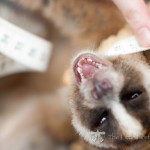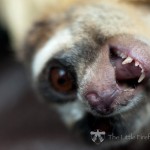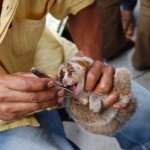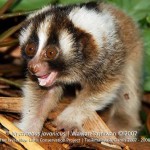Well that’s a Yiddish proverb, but the loris would agree, and most lorises really love their teeth. Being strepsirrhine primates, lorises have really neat teeth! I think the Albuquerque zoo keeper Howard Kaplan explains it best in his song about the slow loris:
Lower front teeth pointing forward
Form a sharp comb in their arc
They clean the fur where encrusted
And scrape the resin from bark!
The behaviour: You can see in this video how a slow loris uses its toothcomb to groom the beautiful soft fur of its companion – this is called allogrooming and guess what? All this solitary stuff is nonsense! Slow lorises are super social and the toothcomb is essential for grooming and maintaining social bonds!
The anatomy: The toothcomb in the slow loris is made up of four incisors and two canines (the teeth that normally look like fangs). So those two fang-like teeth you can see sticking out in the photos are actually premolars. this means that when traders cut out the lorises’ teeth, they are normally removing 8 teeth. This leaves the loris with only 2 premolars and 3 molars to eat with in the lower jaw.
Conservation implications: This is pretty terrible because the slow loris is specially adapted to eat exudates – gums and saps; in fact this can make up most of their diet, and without their toothcomb they cannot be reintroduced to the wild and can even starve to death in captivity. Also, the shattered roots of these broken teeth most often lead to infection and death in affected animals. Finally, it is very hard to reproduce the exudate diet in zoos. This is why many lorises (who eat too many fruits in zoos) get diabetes, dental cavities, become obese and die. Only with extremely specialised care do lorises without teeth even have a glimmer of hope to lead a happy life. Certainly most people keeping them as pets have no chance.
The Science:
Streicher U, Collins R, Navarro-Montes A, Nekaris KAI. (2012).Exudates and animal prey characterize slow loris (Nycticebus pygmaeus, N. coucang and N. javanicus) diet in captivity and after release into the wild. In (Masters J, Genin F, Crompton R): Leaping Ahead: Advances in Prosimian Biology, Springer: New York.
Nekaris KAI, Starr C, Collins RL, Navarro-Montes, A. (2010) Comparative ecology of exudate feeding by Asian slow lorises (Nycticebus). In (Burrows A &Nash L, eds) The Evolution of Exudativory in Primates. Springer: New York. Pp: 155-168.
Swapna N, Radhakrishna S, Gupta AK, Kumar A. (2010) Exudativory in the Bengal slow loris (Nycticebus bengalensis) in Trishna Wildlife Sanctuary, Tripura, northeast India. Am J Primatol. 72(2):113-21.




